For many years, for most people, Chronic Obstructive Pulmonary Disease (COPD) was viewed as a condition of older adults who had smoked heavily for decades. However, recent studies and clinical observations are increasingly showing that COPD is being diagnosed in younger adults — comprising people in their 20s, 30s and 40s — even with little or no history of smoking. Patients and healthcare providers alike must recognise this shift, because early detection and intervention can significantly impact outcomes.
What is COPD?
COPD is a chronic lung disease characterised by persistent airflow limitation and respiratory symptoms such as breathlessness, chronic cough, sputum (mucus) production, and chest tightness. The two principal components of COPD are chronic bronchitis, in which the airways become inflamed and produce excessive mucus, and emphysema, in which the tiny air-sacs (alveoli) in the lungs become damaged and lose their elasticity. Over time, this damage reduces the ability of the lungs to transfer oxygen into the bloodstream and to remove carbon dioxide, making ordinary activities like climbing stairs, walking across a room or carrying groceries much more difficult. While historically the disease struck older smokers, we are seeing more young people with early-stage COPD, which emphasises the need for awareness and early management.
Why COPD is Rising Among Younger Adults
There are multiple contributing factors behind the upward trend of COPD in younger age groups — these go beyond the classic “long-term heavy smoker in his 60s” profile.
1. Air Pollution Exposure
In urban and peri-urban areas of North India — including Amritsar — air pollution levels, especially fine particulate matter (PM2.5), remain high. These small particles can penetrate deeply into the lungs, triggering inflammation, oxidative stress and long-term damage to airway tissues. When young people grow up or live continuously in polluted environments, even without smoking, the cumulative lung injury can accelerate the onset of conditions like COPD. In other words, young lungs are no longer immune to the harmful effects of ambient air pollutants, making them vulnerable to chronic respiratory disease earlier in life.
2. Passive Smoking & E-Cigarettes
While active smoking remains a major cause of COPD, many young adults are now exposed to significant lung risks from second-hand smoke, including in households, social settings, or workplaces. Furthermore, the rise of vaping (e-cigarettes) among younger populations adds another layer of risk: though often marketed as safer than traditional cigarettes, many e-cigarettes still deliver harmful chemicals and ultrafine particles into the lungs. These exposures can initiate or hasten the decline in lung function, leading to early-onset COPD in individuals who may believe they are relatively safe from risk.
3. Indoor Air Pollution
Indoor air quality is a frequently overlooked but major contributor to lung disease — especially in regions where biomass fuels (wood, coal, crop-residue, dung) are burned for cooking or heating without adequate ventilation. Young women and children, in particular, may spend prolonged hours in such environments. The chronic inhalation of smoke, particulate matter and gases from indoor combustion can cause airway irritation, chronic bronchitis and scarring, thereby predisposing individuals to COPD at a younger age. Recognising and reducing indoor pollution is therefore a key preventative strategy.
4. Post-Tuberculosis Lung Damage
India has a significant burden of Tuberculosis (TB). Even after successful treatment of TB, many people are left with residual lung damage — such as scarring, reduced lung capacity or bronchiectasis (permanent airway dilatation). These alterations impair lung function and increase vulnerability to further insults. For a young adult who has had TB (even in adolescence), the risk of developing COPD later is higher than for someone with a completely healthy lung background. Therefore, prior lung infections and their sequelae should not be ignored when evaluating younger patients with breathing issues.
5. Genetic Factors (Alpha-1 Antitrypsin Deficiency)
Finally, in some younger adults, COPD arises despite minimal external risk exposures because of underlying genetic vulnerabilities. A prominent example is Alpha‑1 Antitrypsin Deficiency — an inherited disorder that leaves the lungs unprotected against enzyme-mediated damage, causing emphysema at an unusually early age. While such genetic causes are less common, they serve as a reminder that lung disease in young people is multifactorial — covering environmental exposures, lifestyle factors, previous infections and inherited risk.
Warning Signs You Shouldn’t Ignore
If you are a younger adult (20s–40s) and experiencing any of the following, it’s important to consult a chest specialist without delay. Early evaluation can make a big difference.
- A persistent cough lasting more than three weeks: While many coughs are benign, a chronic “smoker’s cough” or “morning cough” in a non-smoker might signal early bronchitic changes in the airways.
- Shortness of breath or unexplained wheezing on exertion: If you find yourself getting winded by activities you used to do easily (e.g., climbing a flight of stairs), this could reflect declining lung reserve.
- Tightness in the chest or difficulty taking deep breaths: These subjective sensations often accompany airway obstruction or lung tissue damage.
- Frequent respiratory infections: Recurrent bronchitis or pneumonia during young adulthood may indicate underlying airway vulnerability that could progress to COPD.
If you notice these symptoms, don’t dismiss them as “just allergies” or “smoke at work” – early assessment is key.
Early Diagnosis = Better Recovery
The good news is that when COPD is identified early, you can slow its progression and preserve lung quality of life. Diagnostic tools include:
- Spirometry (lung function testing): This measures airflow and lung volumes to detect airway obstruction even before major symptoms appear.
- Chest X-ray / CT scan: These imaging tests reveal structural changes — such as emphysematous areas or airway wall thickening — which help confirm diagnosis and severity.
- Detailed clinical assessment: Specialists will take into account your history of exposure (pollution, indoor air, smoking/nonsmoking), previous lung infections, and family history (for genetic causes).
At Ohri Chest & Critical Care Hospital, Amritsar, we offer a dedicated Chest & Pulmonology Department equipped with state-of-the-art diagnostics and experienced pulmonologists. Our facility provides pulmonary function assessment, imaging services, tailored inhaler/medication therapy, and lifestyle-modification counselling to help younger COPD patients breathe better and live fully.
Living Better with COPD
Managing COPD effectively requires more than just inhalers — it’s a holistic, long-term effort. For younger adults especially, adopting healthy habits early can have lasting benefits. Key management strategies include:
- Quit smoking or vaping completely: If you smoke, vape or are exposed to second-hand smoke, eliminating that exposure is the single most beneficial step.
- Avoid polluted environments: Pay attention to outdoor air-quality alerts, wearable masks if needed, and improve indoor ventilation especially if you live in an area with biomass fuel use or heavy traffic pollution.
- Practice breathing exercises / pulmonary rehabilitation: Structured rehab programmes include breathing techniques, physical conditioning (walking, cycling), and chest physiotherapy — which help strengthen respiratory muscles and reduce breathlessness.
- Maintain a healthy diet and active lifestyle: Good nutrition, regular exercise and maintaining optimal body weight all support general and lung health. Antioxidant-rich foods (fruits, vegetables) help counter oxidative stress in the lungs.
- Get annual vaccinations: Because COPD predisposes you to more severe respiratory infections, flu and pneumonia vaccines are especially important for younger adults as a preventive measure.
Expert Chest & Lung Care in Amritsar
At Ohri Chest & Critical Care Hospital, Amritsar, we specialise in diagnosing and treating lung conditions across all ages — emphasising that COPD is no longer just a disease of older smokers. Our facility is a 100-bed chest and multispecialty hospital located at G.T. Road, Putli Ghar Chowk, Opposite Northern Railway Workshop, Guru Arjun Nagar, Putligarh, Amritsar. You can call +91-9501999829 or +91-9876119456 to schedule an appointment. We are open 24/7 for critical respiratory care and offer an Asthma & COPD clinic, Breathlessness clinic, Quit-smoking clinic and more. (Ohri Hospital) Visit us today for a comprehensive lung-health evaluation and to take control of your respiratory future — because lung disease doesn’t wait for age, and neither should you.


